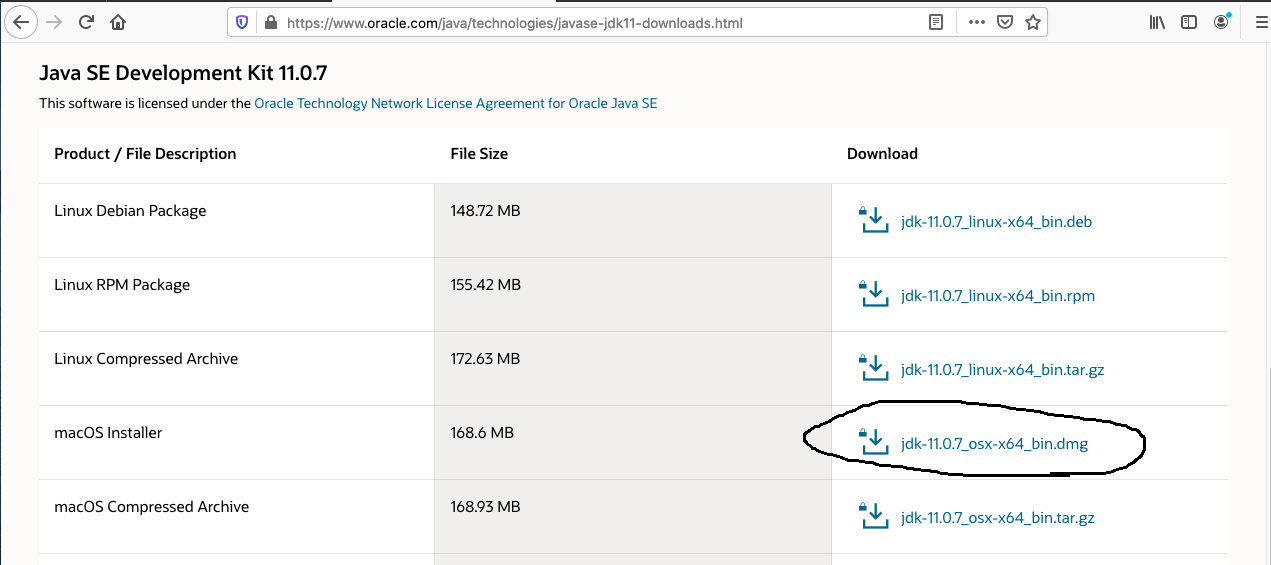Oracle Latest Version Of Java Mac Download
The Vendor column indicates whether the Java release is supplied by Apple or Oracle. The Version column specifies the version of Java that is installed. Reordering the list, by dragging Java SE 10 to the top, makes it the default version of Java. If you install only Oracle Java JRE 10, then it will not appear in. If the installed version is 14 Interim 0, Update 0, and Patch 0, then you see a string that includes the text 14. For example: $ java -version java version '14' Java(TM) SE Runtime Environment (build 14) Java HotSpot(TM) 64-Bit Server VM (build 23.2-b04, mixed mode). Oct 26, 2012 The recent Java Mac OS X 2012-006 update from Apple removes the Apple Java 6 plug-in from your Mac. The Mac OS X Install FAQ will be updated with the next 7u release, but you may find the following information useful in the meantime.
JDK 9 & Later
Oracle's OpenJDK JDK binaries for Windows, macOS, and Linux areavailable on release-specific pages of jdk.java.net as .tar.gz or.zip archives.
As an example, the archives for JDK 13 may be found on jdk.java.net/13 and may be extractedon the command line using
$ tar xvfopenjdk-13*_bin.tar.gz
or
$ unzipopenjdk-13*_bin.zip
depending on the archive type.

JDK 8
Debian, Ubuntu,etc.
On the command line, type:
$ sudo apt-get installopenjdk-8-jre
The openjdk-8-jre package containsjust the Java Runtime Environment. If you want to develop Javaprograms then please install the openjdk-8-jdk package.
Fedora, OracleLinux, Red Hat Enterprise Linux, etc.
On the command line, type:
$ su -c 'yum installjava-1.8.0-openjdk'
The java-1.8.0-openjdk packagecontains just the Java Runtime Environment. If you want to developJava programs then install the java-1.8.0-openjdk-devel package.
JDK 7
Debian, Ubuntu,etc.
On the command line, type:
$ sudo apt-get installopenjdk-7-jre
The openjdk-7-jre package containsjust the Java Runtime Environment. If you want to develop Javaprograms then install the openjdk-7-jdkpackage.
Fedora, OracleLinux, Red Hat Enterprise Linux, etc.
On the command line, type:
$ su -c 'yum installjava-1.7.0-openjdk'
The java-1.7.0-openjdk packagecontains just the Java Runtime Environment. If you want to developJava programs then install the java-1.7.0-openjdk-devel package.
JDK 6
Debian, Ubuntu,etc.
On the command line, type:

$ sudo apt-get installopenjdk-6-jre
The openjdk-6-jre package containsjust the Java Runtime Environment. If you want to develop Javaprograms then install the openjdk-6-jdkpackage.
Fedora, OracleLinux, Red Hat Enterprise Linux, etc.
On the command line, type:
$ su -c 'yum installjava-1.6.0-openjdk'
The java-1.6.0-openjdk packagecontains just the Java Runtime Environment. If you want to developJava programs then install the java-1.6.0-openjdk-devel package.
BSD Port
For a list of pointers to packages of the BSD Port forDragonFly BSD, FreeBSD, Mac OS X, NetBSD and OpenBSD, please seethe BSD porting Project's wikipage.


New Features
jGRASP version 2.0.6_05 Beta adds CSD, interactions, and run support for Java 15 features (text blocks).
jGRASP version 2.0.6 includes dark themes.
The jGRASP Plugin for Eclipse version 1.0.0 Beta 6 adds support for the Eclipse dark theme.
About jGRASP and jGRASP Plugins
jGRASP is a lightweight development environment, created specifically to provide automatic generation of software visualizations to improve the comprehensibility of software. jGRASP is implemented in Java, and runs on all platforms with a Java Virtual Machine (Java version 1.8 or higher). jGRASP produces Control Structure Diagrams (CSDs) for Java, C, C++, Objective-C, Python, Ada, and VHDL; Complexity Profile Graphs (CPGs) for Java and Ada; UML class diagrams for Java; and has dynamic object viewers and a viewer canvas that work in conjunction with an integrated debugger and workbench for Java. The viewers include a data structure identifier mechanism which recognizes objects that represent traditional data structures such as stacks, queues, linked lists, binary trees, and hash tables, and then displays them in an intuitive textbook-like presentation view.
jGRASP plugins for IntelliJ (IDEA and Android Studio) and Eclipse add the viewer and canvas features to those IDEs. For IntelliJ, the viewers and canvas will also work with Kotlin (JVM) code.
jGRASP is developed by the Department of Computer Science and Software Engineering in the Samuel Ginn College of Engineering at Auburn University.
Current Development

We are currently building a gdb/lldb interface for the debugger and visualizations in jGRASP, with support initially for C and C++ and the potential for other languages in the future. In parallel with this, we are developing a viewer/canvas plugin for CLion.
Acknowledgments
Latest Version Of Oracle Java
The development of jGRASP plugins for Eclipse, IntelliJ, and CLion and future jGRASP C/C++ visualizations is supported by the Auburn Cyber Research Center.
Prior development of jGRASP was supported by a research grant from the National Science Foundation.
Latest Version Of Oracle Client
The development of GRASP, the predecessor of jGRASP, was supported by research grants from NASA Marshall Space Flight Center, the Department of Defense Advanced Research Projects Agency (ARPA), and the Defense Information Systems Agency (DISA).
